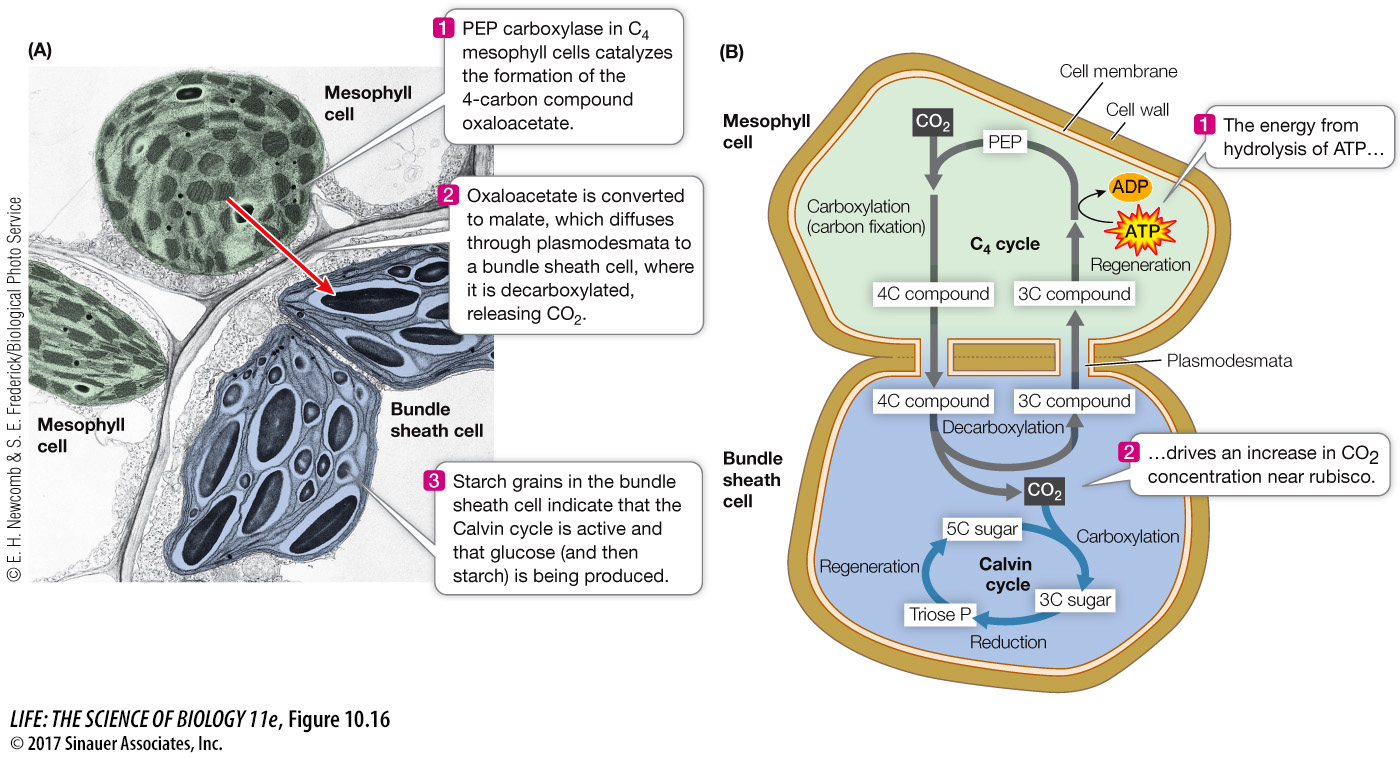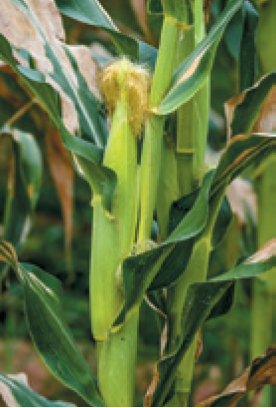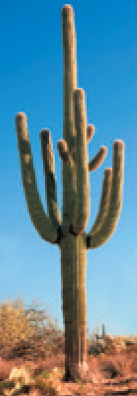C3 plants undergo photorespiration but C4 plants do not
207
Plants differ in how they fix CO2, and can be distinguished as C3 or C4 plants, based on whether the first product of CO2 fixation is a three-

Activity 10.2 C3 and C4 Leaf Anatomy
www.life11e.com/
C4 plants, which include corn, sugarcane, and tropical grasses, make the four-
C4 plants have evolved a mechanism that increases the concentration of CO2 around the rubisco enzyme while at the same time isolating the rubisco from atmospheric O2. Thus in these plants the carboxylase reaction is favored over the oxygenase reaction; the Calvin cycle operates, but photorespiration does not occur. This mechanism involves the initial fixation of CO2 in the mesophyll cells and then the transfer of the fixed carbon (as a four-

208
| C3 plants | C4 plants | CAM plants | ||||
|---|---|---|---|---|---|---|
| Calvin cycle used? | Yes |

|
Yes |

|
Yes |

|
| Primary CO2 acceptor | RuBP | PEP | PEP | |||
| Primary CO2-fixing enzyme | Rubisco | PEP carboxylase | PEP carboxylase | |||
| First product of CO2 fixation | 3PG (3- |
Oxaloacetate (4- |
Oxaloacetate (4- |
|||
| Affinity of primary fixing enzyme for CO2 | Moderate | High | High | |||
| Photosynthetic cells of leaf | Mesophyll | Mesophyll and bundle sheath | Mesophyll with large vacuoles | |||
| Photorespiration | Extensive | Minimal | Minimal |
The first enzyme in this C4 carbon fixation process, called PEP carboxylase, is present in the cytosols of mesophyll cells near the leaf’s surface. This enzyme combines CO2 with a three-
It does not have oxygenase activity.
It fixes CO2 even at very low CO2 levels.
So even on a hot day when the stomata are partially closed and the ratio of O2 to CO2 rises, PEP carboxylase just keeps on fixing CO2.
Oxaloacetate is converted to malate, which diffuses out of the mesophyll cells and into the bundle sheath cells (see Figure 10.15B). (Some C4 plants convert the oxaloacetate to aspartate instead of malate, but we will only discuss the malate pathway here.) The bundle sheath cells contain modified chloroplasts that are designed to concentrate CO2 around the rubisco. There, the four-
Under relatively cool or cloudy conditions, C3 plants have an advantage over C4 plants in that they don’t expend energy to “pump up” the concentration of CO2 near rubisco. But this advantage begins to be outweighed under conditions that favor photorespiration, such as warmer seasons and climates. Under these conditions C4 plants have the advantage, especially if there is ample light to supply the extra ATP required for C4 photosynthesis. For example, Kentucky bluegrass is a C3 plant that thrives on lawns in April and May. But in the heat of summer it does not do as well, and Bermuda grass, a C4 plant, takes over the lawn. The same is true on a global scale for crops: C3 plants such as soybean, wheat, and barley have been adapted for human food production in temperate climates, whereas C4 plants such as corn and sugarcane originated and are still grown in the tropics.
THE EVOLUTION OF CO2 FIXATION PATHWAYS C3 plants are more ancient than C4 plants. Whereas C3 photosynthesis appears to have begun about 2.5 billion years ago, C4 plants appeared about 12 million years ago. A possible factor in the emergence of the C4 pathway is the decline in atmospheric CO2. When dinosaurs dominated Earth 100 million years ago, the concentration of CO2 in the atmosphere was four times what it is now. As CO2 levels declined thereafter, the C4 plants would have gained an advantage over their C3 counterparts in high-
As described in the opening of this chapter, atmospheric CO2 levels have been increasing over the past 200 years. Currently, the level of CO2 is not enough for maximal CO2 fixation by rubisco, so photorespiration occurs, reducing the growth rates of C3 plants. Under hot conditions, C4 plants are favored. But if CO2 levels in the atmosphere continue to rise, the reverse will occur and C3 plants will have a comparative advantage. The overall growth rates of crops such as rice and wheat should increase. This may or may not translate into more food, given that other effects of the human-